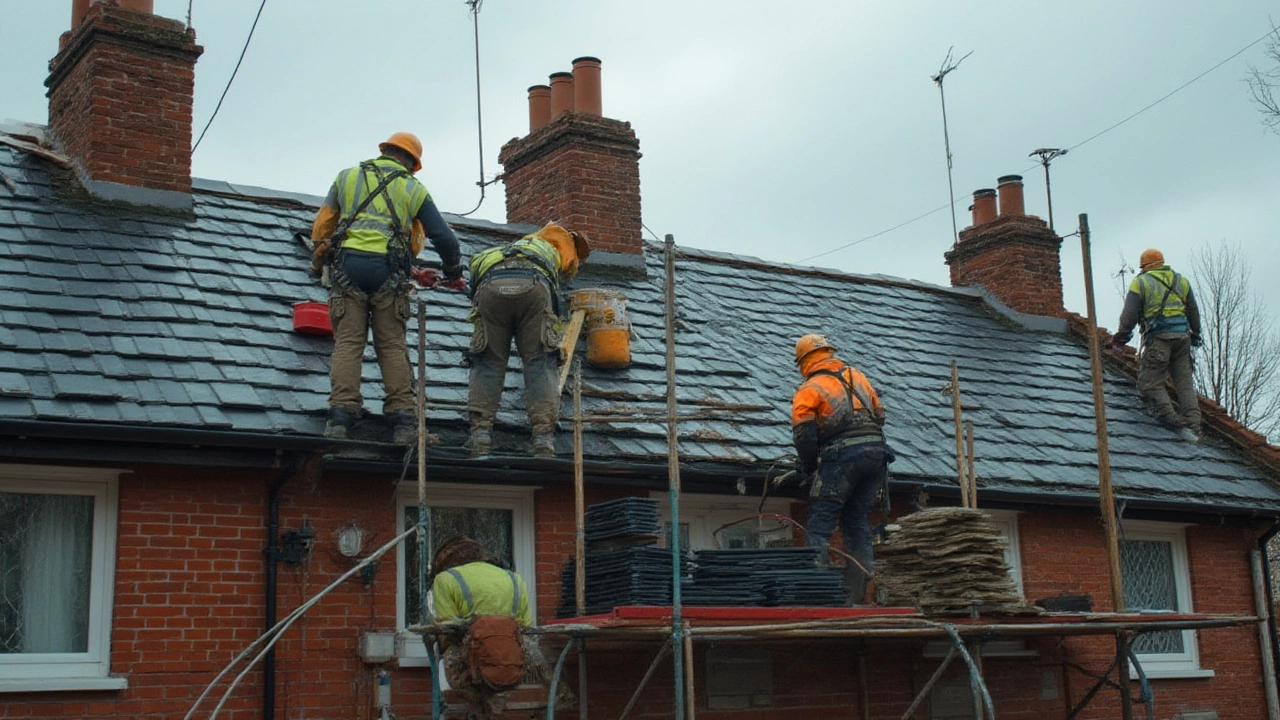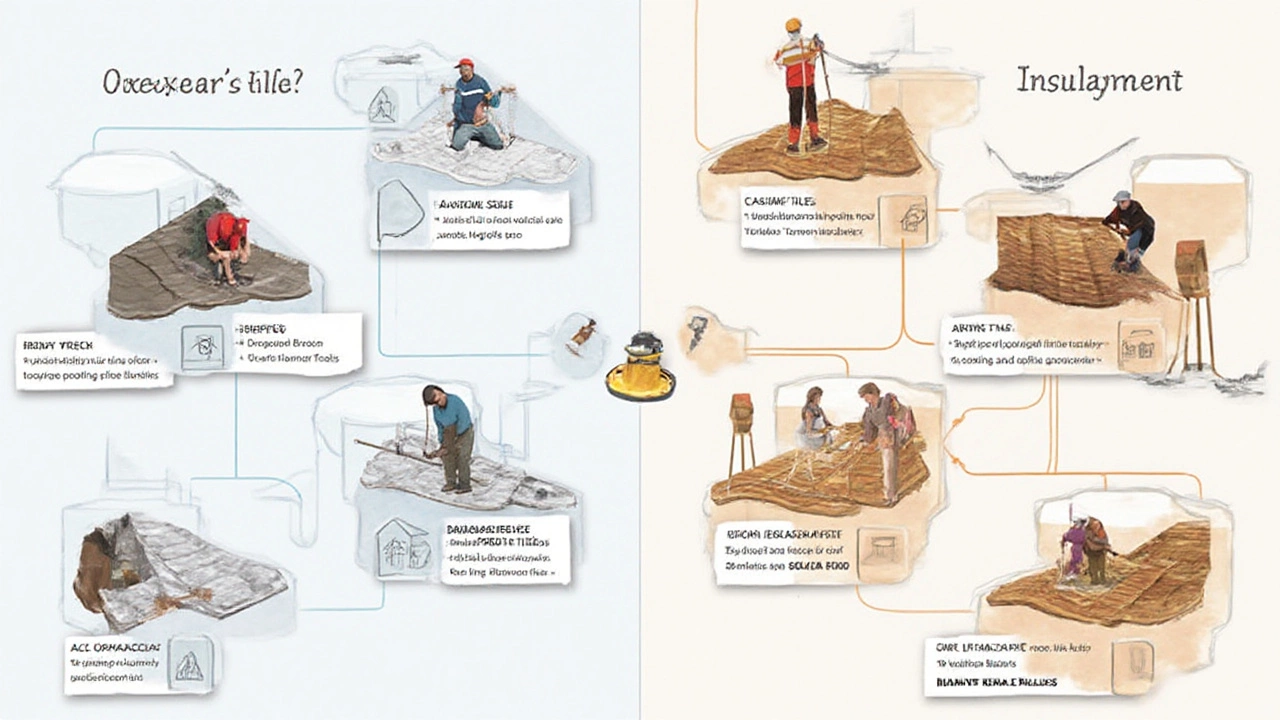Why Is Roof Work So Expensive? Real Reasons Behind Roof Repair and Replacement Costs
 Jul, 10 2025
Jul, 10 2025
Most people don’t really think about their roof until something’s dripping on their head, but as soon as you call a roofer, sticker shock kicks in. Everyone’s got that friend who gasped when the quote came in higher than their car. If you’ve ever wondered why roof work costs so much, you’re not alone. The price isn’t just random or some industry scam. You’re paying for way more than shingles and nails – and once you break it down, the numbers start making sense.
The True Price of Roofing Labor and Materials
Let’s start with the basics: most roofing projects aren’t just a matter of slapping down some new shingles. It’s all about skilled labor and specialized materials. Good roofers don’t just appear out of nowhere. They train for years to master the safety techniques, product knowledge, and quick decision-making every job demands. Think about it: these folks work long hours, often in blazing sun or biting cold, sometimes risking their lives on steep slopes. According to the U.S. Bureau of Labor Statistics, roofing is consistently ranked among the top ten most dangerous jobs in the country. Falls are the leading cause of death in construction, with roofers especially vulnerable. The insurance roofers carry reflects that risk, adding to their overall costs.
Materials aren’t just basic, one-kind-fits-all either. Asphalt shingles are the classic choice, but lately, homeowners want things like architectural shingles, metal, tile, or even eco-friendly options like recycled rubber or solar panels. In the past five years, the price of roofing materials has shot up—mostly due to supply chain bottlenecks, inflation, and the rising costs of oil (which is used in asphalt production). For example, according to 2023 data from the National Roofing Contractors Association, asphalt shingle prices went up 20% in two years, and metal roof panels jumped even more. And it’s not just the surface: underlayment, flashing, ridge vents, ice and water shield, fasteners, sealants—each gets tallied onto your bill.
It’s easy to forget about disposal, too. Old roofing is bulky, heavy, often laced with fiberglass, and sometimes riddled with mold or even asbestos (in older homes). Getting rid of the waste is a whole job in itself, with strict landfill rules and hauling fees to match. Many states now charge extra eco fees for dumping construction materials, driving costs even higher.
What really tips the scale, though, is the expertise involved. Roofers aren’t just swinging hammers—they’re spotting hidden leaks, calculating ventilation, making sure your attic doesn’t become a mold factory, and guessing what the weather will do in the next four hours. Good roofers also give you a warranty, which is a promise that costs them money if anything fails. All those factors add up fast.
If you want to keep costs in check, timing often matters. Roofers are busiest in summer and early fall, so spring or late winter bookings may come with better deals—but you can’t count on it if you wait too long and weather hits. If you need to save, ask about leftover materials from previous jobs or group discounts if your neighbors jump in for a bulk fix. But don’t just chase the lowest bid; a shockingly cheap quote often means someone’s skipping insurance or using untrained labor—risks you don’t want over your head, literally.

Why Roofing Isn’t a Standardized Job
Every roof is an original. There’s no one-size-fits-all plan, even if your house seems just like the one next door. Roofs come in countless shapes and sizes, pitches, and architectural quirks. The steeper or more complex the roof, the more labor it demands. Valley runs, dormers, skylights, and chimneys all add time (and money) because they’re leak-prone problem areas that need special waterproofing. Something seemingly simple—like a “just replace some shingles”—can quickly reveal rotted decking, critter damage, illegal past repairs, or codes that changed since the last renovation. Each surprise means more materials and extra hours.
Building codes are another driver. If your city or municipality tightened rules for wind resistance or fireproofing, you’ll need upgraded materials, more fasteners, or extra layers. In areas hit by hurricanes, wildfires, or hailstorms, insurance requirements push up standards and costs. Inspectors check every step, and failing an inspection means do-overs (at your roofer’s expense if you’re working with a reputable contractor). For homeowners associations, there might be rules about color, product, or installation technique, making it impossible to buy off-the-shelf solutions.
By 2024, drone inspections and satellite analytics made measuring and planning faster—but they don’t eliminate complexity. A weird parapet, uneven edge, or just a surprise wasp nest can still throw off the estimate. Even the direction your house faces affects wear and tear. South-facing slopes, for example, take more UV damage, so roofers might recommend premium products there to ensure the warranty is valid.
Speaking of warranties, higher-quality roofs come with stronger guarantees. But those depend on strict installation guidelines. If a contractor messes up a step, the warranty evaporates. Licensed crews cost more because they have a lot of skin in the game. The cost you pay is about ensuring the job meets both building and manufacturer standards—mess up, and not only could your roof fail, but your home insurance claim might get denied later.
If you want to understand your specific cost, don’t hesitate to ask for a line-by-line quote. Request info about the type and brand of every product, what labor steps are included, and whether cleanup and permits are part of the price. Compare apples to apples—the guy who’s $5,000 cheaper might skip steps you’ll wish he’d covered later. Any red flag like “we don’t need a permit” or “we don’t do written contracts” should make you walk away fast.
Tip: If your home insurance will pay for a repair after a storm, don’t automatically take the payout and pick the lowest bidder. Standards and prices have changed a lot in just the past few years, and insurance companies often use outdated price lists. Show your adjuster recent local estimates. And remember, cutting corners now leads to expensive fixes later—cheap work is never truly cheap if it fails in six months.

What Homeowners Actually Get for Their Money
The million-dollar question: what do you actually get when you pay for roofing? Start with peace of mind. Water leaks don’t just ruin sheetrock; they wreck insulation, short out wiring, and can even cause structural beams to rot or collapse. A well-installed roof raises the value of your home, helps cut utility bills by locking in good insulation and ventilation, and slashes the odds of mold and indoor air quality issues. Real estate agents report that a new roof is one of the top visible features buyers look for—it’s one of the few upgrades that almost always pays off during resale.
Then, there’s durability. Done right, an asphalt roof lasts 20-30 years. Metal roofs can go 50 years or more, and high-end slate is almost forever (which is why you see them on old historic homes). With proper flashing, the risk of leaks around chimneys, skylights, and edges drops close to zero. Many roofing manufacturers started requiring certified installers after 2021 to keep their warranties active, which means only proven professionals can legally install their premium products. That’s another secret to higher costs—it’s not just materials, it’s the guarantee that someone will fix any future problems on their dime, not yours.
The energy cost angle can’t be ignored. Here’s something most homeowners miss: cool roof technology, reflective coatings, and solar-ready materials can actually drop your summer AC bills by up to 20%. The savings come from reducing heat absorption, which keeps your attic and living areas cooler. Several utilities and state programs offer partial rebates for roofs that meet energy efficiency standards, which can help offset the upfront hit. Ask your roofer for info about available credits—they know what’s new in your area.
Safety isn’t just about the workers. Good roofers put up the right scaffolding, wear harnesses, and use fall protection. That makes the job more expensive, yes, but it keeps workers alive and reduces the risk that anyone (homeowner or kid) gets hurt during the project. If someone gets injured working on your house and their employer cut corners on insurance, you could be liable. That’s a nightmare scenario, and another reason to skip “handyman” specials that seem too good to be true.
Finally: time is money, and you don’t want the job dragging out. Good contractors coordinate everything in advance and handle local permits, supply delivery, and inspections. In summer 2024, contractors faced major delays thanks to labor shortages and storms knocking out supply lines, so fast completions came at a premium. You might save by scheduling in the off-season, but don’t put things off too long; leaks and wind damage only get worse (and more expensive) the longer they’re ignored.
If you’re planning a roof project, my advice is to get several quotes, research each company thoroughly, and double-check their licenses and insurance. Don’t just look at the total price—dig into the details, ask about past jobs, and read every contract before signing. With all the complexities and risks, good roofing work is always worth the investment.
